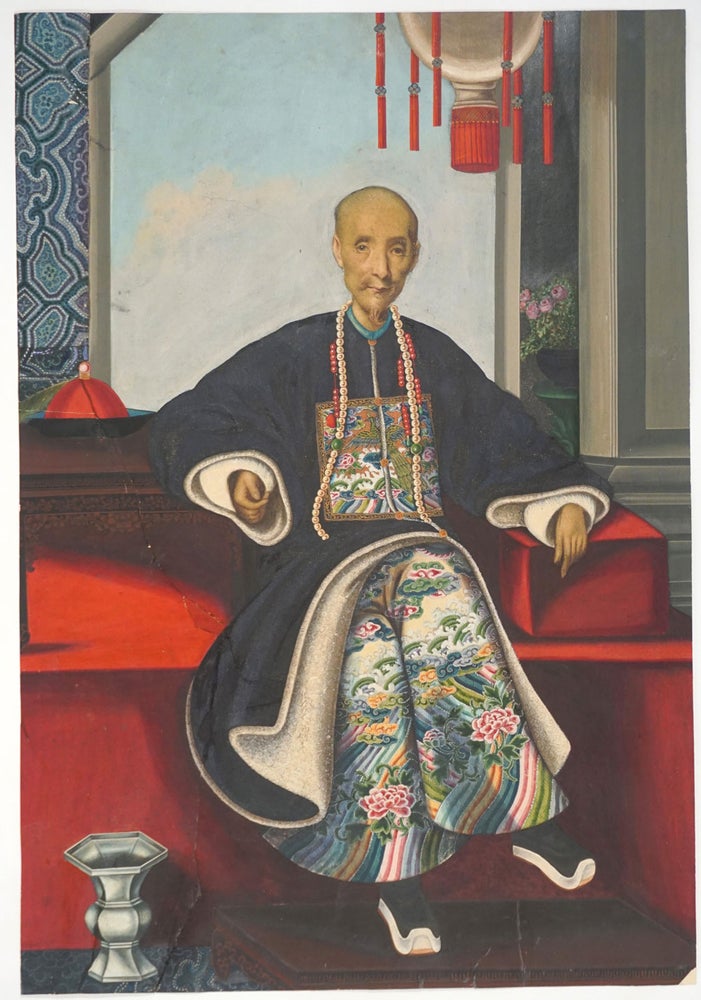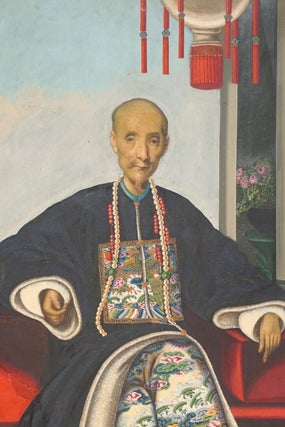Houqua. A Chinese Merchant. A Chinese trade painting, portrait.
Canton? c. 1830. Painting. An early gouache portrait of Houqua, considered the richest man in the world in the 1830s.
'This gouache portrait of Howqua, exist in several versions and sizes, from full-length to head and shoulders ... some in oils and others in gouache. They seem to have had their origin in a group of portraits executed by Chinnery, the portrait of Howqua, was probably shipped to England on January 31st 1830. Following and adapting Chinnery's prototypes, Lamqua must have done a brisk business in such portraits. In particular, the distinctive features of Howqua – domed forehead, hollow cheeks, wispy beard – gained an almost iconic status, the acceptable face, as it were, of the China trade.' (P. Conner, 'Lamqua Western and Chinese Painter', Arts of Asia, March-April 1899, p.54).
This portrait has elements of several images of Houqua. The basic structure is based on the portrait held at the Metropolitan Museum of Art in the style of George Chinnery. In that portrait, Houqua sits on a red banquette, looking straight at the painter, his legs crossed, wearing a dark blue robe with white cuffs, a central elaborate panel of embroidery at his chest and wide pants decorated with diagonal strips of blue, green and red. He also wears two or three strings of beads, his red domed hat to the left, a wooden doorway framework and an open space behind with a sky and a Chinese red-tasseled lantern hanging above him to the right. There is also a silver colored metal object at the left of his foot and a wooden footstool. In this portrait, the face is of an older Houqua, appearing similar to the Tinqua "Portrait of Houqua" portrait on ivory also at the Metropolitan.
This image varies from that format, most strikingly the intricate dragon coat pattern which we have not been able to trace in any other variant of this portrait. Also, the harbour background found in many examples has been blocked by a wall extending from the pillar on the right.
Howqua, the representative of the thirteen factories among the Guangzhou merchants. The subject of this portrait is probably Wu Bingjian (1769-1843), the richest man on earth during the Jiaqing and Daoguang periods, or possibly his fifth son, Wu Shaorong (1833-1856). Howqua Wu Bingjian, had risen to become the most senior of the hong merchants in Canton, one of a select few permitted to trade in silk and porcelain with foreigners. The word hong (?) refers to both a type of building and a Chinese merchant intermediary within the Canton system of trade.
Howqua’s personal wealth was estimated to be around US$26 million by 1834
He contributed a third of the US$3 million that China’s Qing dynasty was required to pay in reparations to the British after the 1842 Treaty of Nanking that ended the First Opium War.
He had close ties with powerful contemporaries such as James Matheson, William Jardine, Samuel Russell and Abiel Abbot Low.
Gouache portrait on paper, 20 1/4 x 14". There are a number of expertly repaired cracks that are barely visible as well as a matching Chinese pattern strip of paper applied to the vacant top left corner. Good + overall. Item #27889
Price: $15,000.00




